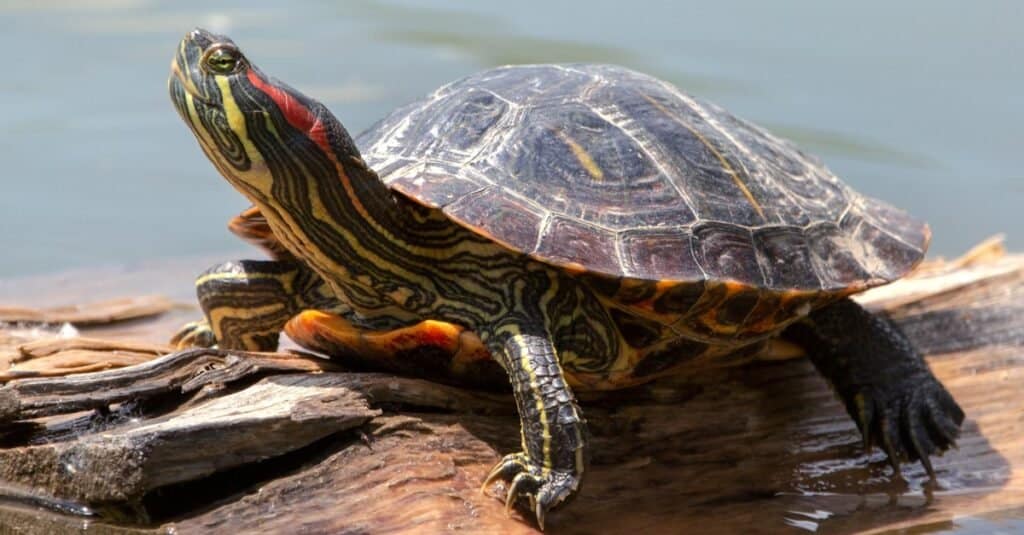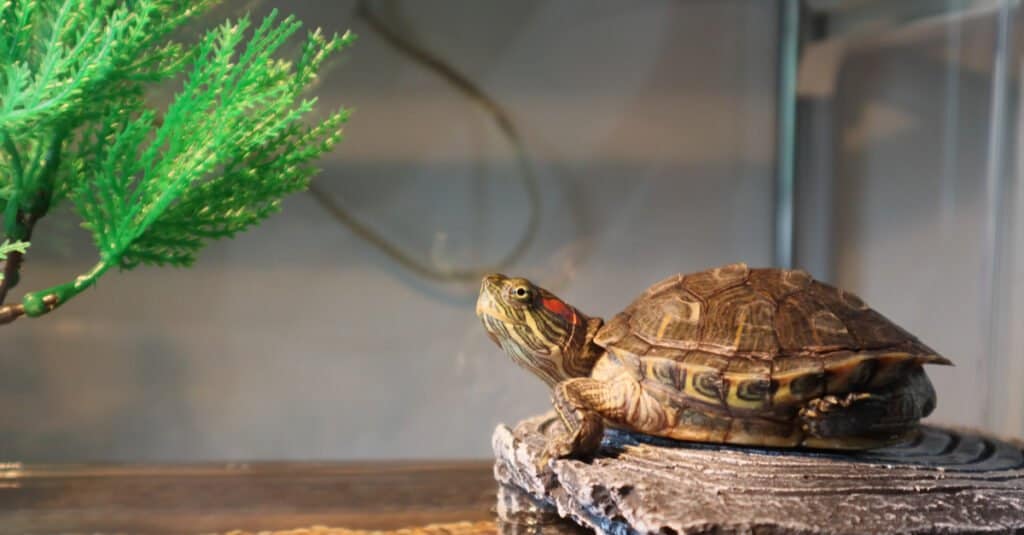Pond turtles belong to the Emydidae family of turtles, which includes more than fifty species of freshwater turtle. They live in slow or stagnant freshwater across North America, parts of South America, Southern Europe, and Southeast Asia. Pond turtles make popular pets, but many species are currently endangered, and some present threats as invasive species. But just what do all these different types of pond turtle eat?
Here, we’ll learn more about some of the best known pond turtles, and what they eat. Then, we’ll go into a little more detail about what specific species like to snack on, and how they make it through the long winter months. Finally, we’ll go over what to feed your pet pond turtle, and explore what baby turtles eat.
What Do Pond Turtles Eat?

Pond turtles are generalist opportunists and will eat anything they can catch
©iStock.com/Alan Doucet
Pond turtles eat a variety of insects, crustaceans, aquatic plants, and fruits. They are primarily omnivores, though each species has a distinct diet.
Pond turtles comprise one third of all turtle species on earth. They are frequently called terrapins, or marsh turtles, and their diets can vary widely. The pond turtle’s diet is determined by their location, size, age, and species. They are opportunistic generalists, which basically means they won’t turn down anything that makes an easy meal. Here are a few of the pond turtle’s favorite foods:
- Insects: spiders, beetles, millipedes, grasshoppers, flies, aquatic insects, larvae, snails
- Amphibians: frogs, toads, newts, salamanders
- Crustaceans: crawfish, freshwater crabs
- Annelids: earthworms, leeches
- Aquatic plants and algae
- Fish
Some species of pond turtle also eat fruit that has fallen on dry land. Many also eat carrion, especially dead fish. Pond turtles won’t turn down a meal, and eat everything from pond algae to small fish.
What Do Wild Pond Turtles Eat?

Red-eared sliders are invasive in many areas and should not be released into the wild under any circumstances
©Korkin Vadim/Shutterstock.com
There are more than fifty species of wild pond turtle, with many subspecies. Here, we’ll take a closer look at the diets of some of the most common species.
- Western Pond Turtle (Actinemys marmorata): These turtles are native to the West Coast of the United states and are currently listed as endangered. Western pond turtles eat primarily aquatic insects, flies, beetles, amphibians, fish, worms, crustaceans, grasshoppers, and aquatic plants; they are omnivores, but are mostly carnivorous. They eat solely underwater, as they cannot swallow air.
- Red-eared Slider (Trachemys scripta elegans): Red-eared sliders are the most popular choice for pet turtles. They are native to the southern reaches of the United States and northern Mexico, though they are invasive in many areas due to their release into the wild by well-meaning owners. In the wild, red-eared sliders primarily eat fish, dead fish, frogs, and aquatic plants; they are omnivores.
- Giant Asian Pond Turtle (Heosemys grandis): This pond turtle is native to Southeast Asia and is currently listed as critically endangered. Giant Asian pond turtles eat worms, snails, larvae, snails, aquatic plants, carrion, and fruit that has fallen to the ground; they are omnivores.
- Box Turtle (Terrapene): Box turtles are the most common type of pond turtle throughout North and South America. They are omnivores and eat anything they can find; including insects, millipedes, earthworms, annelids, aquatic and terrestrial plants, and fruit.
- Painted Turtle (Chrysemys picta): These pond turtles are native to North America. Painted turtles eat algae, aquatic plants, insects, fish, amphibians, and crustaceans; they are omnivores.
- European Pond Turtle (Emys orbicularis): European pond turtles are native to southern Europe. They eat anything they can get, including aquatic plants, amphibians, and fish. They are omnivores.
Surviving Through the Winter
Pond turtles are common in the Northern Hemisphere, where winters can be long and harsh. Prey items are scarce during these cold months, and waters turn icy, forcing pond turtles to slow down until spring.
In the winter, most species of pond turtle eat very little, choosing instead to either brumate, or hibernate. Brumating means that the turtle slows down everything; its breathing, its heart rate, and its metabolism, so that it needs very little food to survive. Hibernation happens when the pond turtle actually buries itself in the mud at the bottom of the pond and waits until spring.
What to Feed Your Pet Pond Turtle

Pet pond turtles eat insects, leafy greens, specialized turtle pellets, vegetables, and fruit
©Mark Leung/Shutterstock.com
Pond turtles make popular pets; they are relatively easy to take care of, and some can live up to thirty years. The health and longevity of your pet pond turtle is largely dependent on what you feed them, and how well kept their environments are.
Pet pond turtles eat special turtle pellets, insects like crickets, mealworms, waxworms, and earthworms, feeder fish, and leafy greens like kale and collard greens. They can also have vegetables like shredded carrots and cut up squash. Pet pond turtles also eat fruit, especially apples, melons, and berries. Like vegetables, fruit must be cut up small enough for your pet pond turtle to eat easily.
If your pet pond turtle doesn’t eat all of their fresh food within a few hours, be sure to remove it from their enclosure, as wilted or rotten food can make them sick. Consult a veterinary expert on the best dietary regime for your pet pond turtle.
Pond turtles require clean enclosures with at least one source of fresh water. Most species are unable to regulate their internal temperatures, and must have a source of warmth, like a heat lamp, to stay warm enough.
What Do Baby Pond Turtles Eat?
Pond turtles lay eggs in clutches, often along the banks of rivers or ponds. The sex of the offspring is entirely dependent on the temperature of the eggs as they incubate. Once the eggs hatch, the baby turtles are left to fend for themselves.
Baby pond turtles eat a variety of plants and animals, including small insects, aquatic plants, larvae, and algae. Their diets tend to be more carnivorous then those of adult turtles; this may be because they require a lot of protein to grow. They are often eaten by larger predators, like raccoons, birds, bass, and even humans.
The photo featured at the top of this post is © Mark Leung/Shutterstock.com
Thank you for reading! Have some feedback for us? Contact the AZ Animals editorial team.







